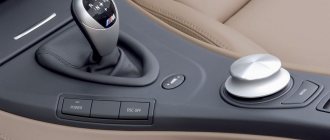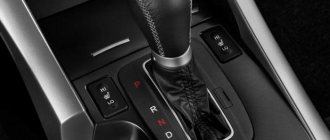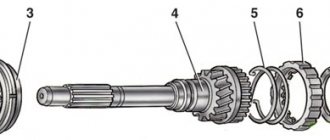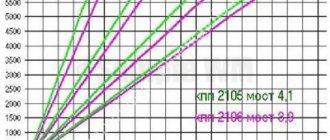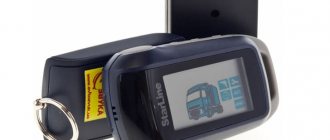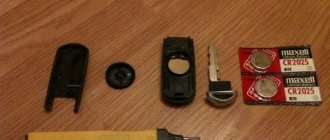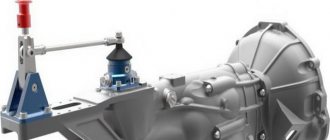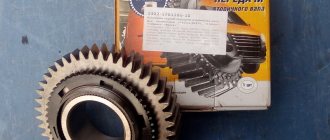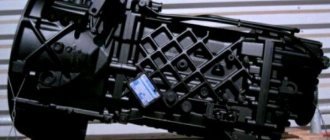What kind of automatic machine does the Lada Vesta have?
Automatic and manual transmissions The new product has two transmission options: domestic automatic and French manual.
Since many tests of the car were carried out (automatic test drive video below), we can confidently talk about the pros and cons of the first and second gearboxes. The difference between AMT (robot) and automatic transmission is quite significant. On the latter, switching occurs without driver participation. The first, in fact, is a mechanics modified by an electrical unit.
The global market has shown that the frequency of implementation of AMT in vehicles is beginning to fall, this is due to the following factors:
- the mechanism operates with small and unauthorized delays, which makes the driver very nervous;
- the robot switches gearbox gears quite sharply, this is noted by a large number of owners who have a colossal love for dynamic driving;
- The robot does not reduce gears in a timely manner on slopes, and when driving up a mountain in reverse, it excessively “rips” the gears.
A short tour of the characteristics of the Lada Vesta car
The Vesta model was launched into mass production in the fall of 2015. This is one of the first modern cars, the image and design of which was developed virtually from scratch. For this car, its own platform was designed, called Lada S, which was soon converted into the Lada V platform. The car compares favorably with its colleagues in the fact that borrowed parts were used to a minimum.
| Characteristics | Options |
| Vesta is a new middle-class sedan and outperforms all previous Lada sedans in size. | Its length reaches almost 4.5 meters, in the hatchback version - 4 and a quarter meters. |
| It has 3 configuration options. | Options: classic, comfortable and luxury. |
| In addition to the original dimensions and design, Vesta was equipped with a specially designed suspension with a change in the operating principle of the levers and the wheel turning system. | |
| This VAZ model is equipped with a domestic engine. | 1.6 liter engine with 106 horsepower. |
| An arc motor is also being introduced. | 1.8 l, also VAZ, which is more powerful - 122 l. With. |
The steering was borrowed from Renault Megane. Also, some individual components were integrated from the ideas of the Renault Nissan concern (brake system, radiator). Soon, due to the rise in gasoline prices, developers will begin producing production Vesta models with gas equipment, which will make it possible to refuel the car with cheaper methane. This implementation has already passed the first tests and is almost certified.
The Lada Vesta transmission is offered in two types: manual and robotic (an alternative to an automatic transmission).
The manual transmission was not developed from scratch. The engineers initially planned to take the components of the five-stage VAZ 2180 transmission as the basis for its design. But this type of box in this form is impossible to use in a modern car due to its high noise level. AvtoVAZ designers had a period of time allotted to reduce the noise level of the updated gearbox. But within the allotted time, the designers were unable to completely “regenerate” the old box so that it would not make noise. An alternative solution was to use an analogue from French Renault cars as a prototype for the mechanics. This box was optimized to the required amount of noise emitted and the required convenience of switching speeds. The second transmission option is semi-automatic, developed on the basis of a domestic transmission. Let's look at what gearbox Vesta is equipped with, besides the mechanics.
Let's not get carried away
The CVT Vesta and the “mechanical” have the same mass - 1230 kg. An imported “aluminum” engine is lighter than a domestic “cast iron” one exactly as much as a CVT is heavier than a manual one. But 113 forces, partially eaten up by the variator, are clearly not enough for Vesta to vigorously overtake on the highway.
When there is a slow-moving vehicle ahead, there are no special problems. However, if you push the car at least from 90 km/h, the engine howls more than it drives. “Measure twice, overtake once” is the credo of the owner of a Vesta with a CVT.
It turns out that the test cars on the highway exceeded the declared consumption for the combined cycle by more than a liter (7.1 and 7.4 l/100 km, respectively)! This can be partly attributed to untested engines, and partly to the mountainous terrain. But still, don’t count on a “free” ride with a CVT.
In the city on Vesta CVT after the robot - grace! No glitches, no slow switching, no faulty logic. Even with AMT version 2.0 it cannot be compared, although the firmware has greatly improved the character of the robot. The CVT is better in the city! But if you like dynamic country driving, take a car with a manual transmission.
Use of automatic transmission on Lada Vesta cars
In mass production, Lada Vesta with automatic transmission is equipped with an AMT robotic gearbox. It is based on the VAZ 21827 manual transmission. A control unit, drive and actuators from the German company ZF have been added to the manual transmission.
AMT automatically releases the clutch. To start driving, remove the selector from the neutral position and press the accelerator.
The robotic automatic transmission has a lot of shortcomings, which is confirmed by negative reviews from car owners and the low level of sales compared to the Lada Vesta with a manual transmission. A car with AMT jerks when starting off, and gear shifting is accompanied by jerks.
Many complaints about the automatic transmission arise from the slowness of gear shifting. This is especially noticeable during dynamic sports driving. The electronics turn on the required pair of gears at the wrong time. A similar problem occurs when driving uphill. The downshift is engaged with a noticeable delay.
A special feature of the AMT is the impossibility of parking on a slope without applying the hand brake. This is due to the fact that the car may begin to roll. This may lead to an emergency.
A robotic automatic transmission also has a number of advantages. It has a lower cost compared to a classic machine. The AMT in the Lada Vesta has protection against engaging the wrong gear, which conventional mechanics lack.
At the end of winter 2021, the plant in Izhevsk began production of the updated automatic transmission AMT 2.0. The box is free of most flaws and shortcomings. One of the main advantages is the appearance of the “crawling” Creeping Mode. It allows you to create the effect of a classic machine gun. The car starts moving immediately after releasing the brake pedal. Without pressing the gas, there is enough traction to overcome the speed bump.
The upgraded automatic transmission AMT 2.0 works much faster. The average gear shift time has decreased. But despite all the improvements, it is impossible to release the brake in “creeping” mode on an incline without using the handbrake. The test drive showed that the Lada Vesta manages to roll back before the automatic transmission engages first gear.
Slowness when changing gears has also been eliminated. The algorithm for turning on servos has been optimized. In this case, the switching speed is interconnected with the force of pressing the accelerator pedal.
A feature of the AMT 2.0 automatic transmission is that all modernization was carried out exclusively by software, without affecting the design of the box. Despite this, official dealers refuse to reflash old controllers.
From time to time, rumors arise that Vesta will be equipped with a classic automatic transmission. The most common assumptions fall on the Jatco JF414E. Despite this, company president Nicolas More denies the possibility of installing a four-band automatic transmission. Jatco JF414E is significantly outdated and is not suitable for Lada Vesta. The plant is working on creating a six-speed automatic transmission. The appearance of an automatic transmission on the Lada Vesta should be expected in 5-7 years.
The choice between replacing and repairing a manual transmission
French-made manual transmissions are very repairable, but spare parts for their restoration are not always available. Therefore, sometimes it is easier to purchase a new or contract unit. The cost for a new manual transmission starts from 40 thousand rubles. The contract unit has a price of 6,000 rubles.
Domestic-made mechanical boxes are mainly repaired. From a major overhaul to the next overhaul, a manual transmission can cover 150-200 thousand km. Car owners usually buy a new box or contract unit only if the unit has serious deformations or significant wear. From an official dealer, a mechanic costs from 35 thousand rubles, and from a car wrecker - from 5,000 rubles.
CVT for Lada Vesta
The Franco-Japanese corporation Renault Nissan is providing Russian designers with a CVT, which they plan to install on AvtoVAZ’s new product. This device has proven itself when used on units that require a stepless reduction or increase in the gear ratio.
- the variator creates smoothness during vehicle acceleration;
- the mechanism reduces the car's fuel consumption;
- expensive repairs are the only drawback of the variator.
Features of AMT in comparison with Lada Vesta automatic
Robotic gearbox Russian designers decided to take a risk and create their own robot with five stages, relying on the following advantages:
- Production is cheaper than designing a manual transmission and an automatic transmission. On the dealer market, a “robot” costs about 20,000 rubles, which is two times cheaper than an automatic transmission (automatic transmission).
- The fuel consumption of a Lada Vesta automatic or robot is significantly reduced.
- There is no need for frequent diagnostics and repair of the robot.
- The mechanism has built-in protection against unauthorized engagement of the gear at any speed.
- The automatic transmission consumes three times more oil than the Lada Vesta robotic gearbox.
- During driving there is no vibration of the lever, smooth clutch is ensured even during sudden pressure on the gas pedal.
In their development, domestic designers took into account the experience of foreign engineers and began to use German actuators (actuators), as well as French-made clutches in their transmissions. An option for clutch wear compensation is installed inside the AMT Lada Vesta. In addition, it does not need to be warmed up before starting work. An automated manual transmission weighs much less than an automatic transmission, which reduces gas mileage when driving.
A Lada Vesta car with a robotic gearbox cannot be left on a rolling surface without fixing the hand brake. Otherwise, it will move backward, which can lead to an emergency.
Half a hundred from above
Jatco is used even on the cheapest modifications. Minimum - 736,900 rubles for a CVT sedan, maximum - 982,900 rubles for SW Cross with a CVT and all options. Competitors are on average 80,000–120,000 rubles more expensive with similar power and a similar level of equipment.
Only 9% of Vesta buyers chose cars with an AMT robot. And for Kia and Hyundai, almost three quarters of sales are versions with automatic transmission: even in the budget segment, people are willing to pay extra for comfort.
Now Lada has opportunities for growth. Marketers expect to increase the share of versions with a CVT to at least 30%.
I wonder if the next step would be to install a 150-horsepower 1.3 turbo engine from Arcana on Vesta? It would reveal all the capabilities of the chassis! In 2021, Vesta will receive a restyling, and who knows?
According to official data, Vesta with a CVT is the fastest of the “automated” versions of the model. The 1.6 CVT sedan accelerates to hundreds faster than the 1.8 AMT version by 0.8 seconds (11.3 versus 12.1), the station wagon - by 1.1 seconds (12.2 versus 13.3). Subjectively, the version with a 122-horsepower engine drives more vigorously.
| Better for the city than AMT | High fuel consumption |
